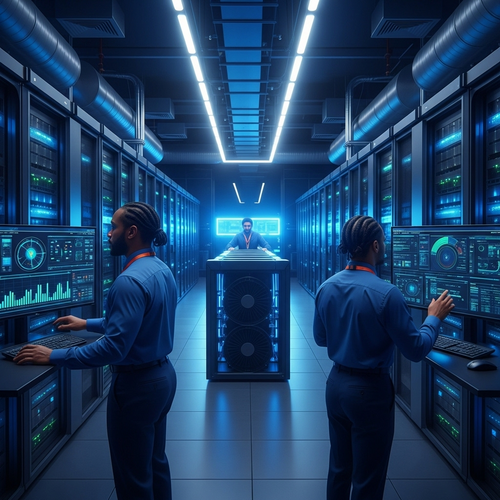AI has kind of reshaped how we ask questions, write code, and even write birthday cards—for better or worse, to say the least. One wild part of all this that doesn’t always get the spotlight? The electricity behind it. Yep, AI eats up a lot more power than you might think. With ChatGPT being one of the go-to AI instruments out there today, it’s worth asking: how much energy does ChatGPT use?
So, if you’ve ever wondered what it takes to keep the chatbot rolling at all hours, let’s break it down. From the power-hungry training stages to the energy it needs just to answer your questions, it’s more than just digital smoke and mirrors.
Why Talk About ChatGPT’s Energy Use at All?

Honestly, I feel like not enough people know about this stuff. AI isn’t just software floating out in the internet ether—it lives in massive data centers full of physical servers. And physical servers? They run hot. Like, Texas-summer hot. Cooling and powering these machines is a full-time job on its own.
Understanding how much energy ChatGPT uses isn’t just for hardcore tech people either. It affects everything from electricity costs to climate discussions. Not gonna lie, this kind of shifts how I see chatbots in general.
Presentation to ChatGPT’s Power Trail

What Happens Behind the Scenes When You Ask a Question?
When you send ChatGPT a message, it doesn’t just magically respond. It wakes up a chunk of computer equipment in a specialized environment (usually a data center). Then it does some rapid-fire number crunching—millions of calculations in seconds. Think of it like starting a car just to drive down the driveway. Simple output, but there’s a lot going into it.
This moment, known as an inference query, happens every time you type something into the box. And, well, ChatGPT power usage per request? That’s where things get intense.
Quick Numbers on ChatGPT Power Usage Per Request
Let’s break it down real quick. While OpenAI doesn’t dish out specific figures for ChatGPT, industry experts estimate that each question a user types into a large model like GPT-4 can use up to four to five times the energy of a Google Search query. One educated guess pegs that at roughly 0.3 to 0.5 watt-hours per request.
That might not sound like a big deal until you multiply that by millions. As in, millions of users, each asking the bot questions every second around the globe. The consumption adds up—fast.
How Does ChatGPT Stack Up Against Google?

I could be wrong, but I kinda get the vibe that people think every search engine and chatbot runs on the same juice. But here’s the deal: ChatGPT vs Google search energy is like comparing a bicycle to a Tesla. Both get you places, but one burns through way more battery doing it.
Google has streamlined its search algorithms over decades—millions of tiny tweaks to make them super efficient. In contrast, ChatGPT has to think a lot more each time you ask a question. It’s not pulling from indexed pages like Google; it’s generating sentences on the fly. So yeah, way more computing, way more electricity.
What About Training the Model? That’s Where It Gets Brutal

Okay, answering questions is one side of the coin. But how about training ChatGPT in the first place? Let’s just say—it burns through energy like there’s no tomorrow.
To give one illustration, when GPT-3 was being trained, it reportedly used around 1,287 megawatt-hours of electricity. That’s about the same energy it would take to power 120 U.S. homes for a year. GPT-4 likely required way more, but details are hush-hush for now.
Another way to phrase it? Training an advanced AI model is like teaching an army of robots to write poetry, answer math problems, and hold polite conversations—all at once. Yeah, it’s hard. And it drains a lot of power.
Energy Consumption of AI Models: Why It’s Not Just About ChatGPT

Sure, ChatGPT is the poster child now, but what about the rest of the AI tribe? Models from companies like Anthropic, Meta, or Google also demand insane levels of electricity. To be honest, ChatGPT is just one piece in a much bigger puzzle.
Most large AI models depend on a process called deep learning. And deep learning isn’t exactly chill—it involves thousands of processors (GPUs) running simultaneously, often for weeks. That’s a mountain of energy usage just to get those chatbots up and running.
Impact of AI on Data Center Power
This might sound weird, but new AI products are changing data center architecture like influencers change outfits. According to some industry folks, AI-related workloads now drive up to 15% of total data center power. And yes, the number’s climbing.
To keep up, data centers need better infrastructure, more access to renewable resources, and cooling systems sharp enough to chill a volcano. For what it’s worth, I kinda admire how tech teams are scrambling to adapt. It’s like surfing bigger and bigger waves—you either ride it or get swallowed whole.
Is All AI Bad for the Planet?

I mean, it’s not all gloom. Some AI models actually help reduce energy use. Predictive dialing? CRM integration tools? They save folks time and money, and yeah, that conserves energy in a roundabout way.
So while we should totally care about the energy conversation around AI, let’s also acknowledge that not all models are massive energy drains.
What Can Be Done About It?

If you ask me, companies should be more transparent about AI power demands. Some already are experimenting with cleaner tech—like using wind or solar energy to power data centers. That’s a move in the right direction.
Also, developers can design smaller models that are more efficient. It’s like getting the same performance from a scooter instead of a sports car. Efficiency on tap.
FAQs
It’s estimated that a single ChatGPT question can use about 0.3 to 0.5 watt-hours of electricity. Multiply that across millions of users, and it becomes a serious consumption issue.
Yes. Due to the way ChatGPT generates content instead of pulling from a database, each request usually uses more energy—sometimes four or five times more than a Google Search.
Training involves running thousands of specialized GPUs for weeks. These processors work together to crunch an incredible number of data points, making them very power-hungry.
Absolutely. Companies are exploring low-power server designs, cleaner energy sources, and more efficient AI models to bring down the footprint.
Maybe it’s just me, but I think it depends on how it’s developed and used. With the right mix of efficiency and clean energy, AI doesn’t have to be a drag on the planet.
Final Thoughts
The way I see it, knowing how much energy ChatGPT uses isn’t just a nerd-fact—it’s part of the bigger conversation on our tech habits. AI, no doubt, is powerful. But power, well, it needs power. Literally.
If you’re someone who leans on AI daily—whether for customer support, content writing, or just random questions—it makes sense to at least know what goes into each response.
So next time you’re firing off ChatGPT prompts like rapid-fire texts, maybe pause for a second. It’s not just a cloud-based genie. It’s a full-blown power consumer packed with advanced calculations under the hood.
Curious what else ChatGPT can do? Dive deeper and discover more ways to unlock its potential—responsibly.




